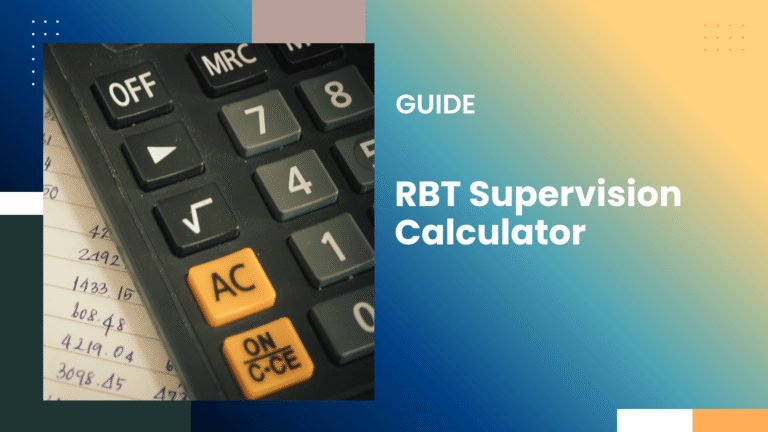How to Be a Better RBT: 8 Ways To Improve Everyday
Learn How to Be a Better RBT: 1. Be Curious 2. Be Precise 3. Be Data Obsessed (But Not Robotic) 4. Reinforcement 5. Ask for Feedback 6. Be Understanding.

As you already know already, Registered Behavior Technician (RBT) isn’t a job that you can coast through. You need to show up every day, and real lives are on the line.
What you do—and how well you do it—directly affects your clients’ ability to learn, grow, and function.
And if you’re anything like me, you probably didn’t get into this field just to “clock in.” I’m sure you got into it to make a difference.
So the question becomes: how do you get better?
When I say, better, I am not talking about just following the plan or tracking behavior. I’m talking about showing up more effectively, more ethically, and more skillfully—with confidence, clarity, and care.
1. Be Precise
For me, it’s quite simple, and that means Know the Plan Cold—Then Personalize the Delivery.
It means every great RBT starts with precision. You also need to follow that behavior intervention plan (BIP) or skill acquisition plan (SAP) with fidelity.
Not loosely. Not mostly. Fidelity.
But here’s where it gets real: you also need to deliver those plans in a way that fits the client in front of you.
You are basically matching your tone, your prompts, and your reinforcement to the moment.
For example, I once had a nonverbal client who loved trucks. We ran manding drills using a toy dump truck. His data? It soared.
Not because I changed the plan, but because I delivered it in a way that worked for him.
My personal advice for you is not to ad-lib the program. Instead, I want you to collaborate with your BCBA to make those plans more dynamic, more tailored, but still consistent.
2. Be Data Obsessed (But Not Robotic)
You already know this: ABA runs on data.
But the difference lies in how you look at the data. You can either scribble numbers without understanding what they mean, which inherently means you’re missing the point.
Or your job is to turn behavior into numbers that your team can trust. That means:
- Defining behaviors clearly (no guessing what “tantrum” means)
- Measuring consistently (intervals, duration, frequency—get fluent in all of them)
- Reviewing your data and asking questions when things trend up or down
Personally, I like to graph my data during supervision and walk through it with my BCBA.
I’ll say, “Here’s what I’m seeing. What do you think is driving that spike?” That’s not just good data collection—that’s active clinical thinking.
3. Reinforcement
Let me say this clearly: reinforcement is everything.
There are two ways that will lead to working negatively for you: 1. The Wrong Way, and 2. Inconsistent.
If you’re using it the wrong way, you’re wasting trials. And if you’re using it inconsistently, you’re sabotaging progress.
So, what works?
Find what the client wants in that moment, and use it immediately. Not two seconds later. Not after you write something down.
Reinforcement is powerful when it’s relevant and immediate.
Example: I worked with a teenager who liked memes. No joke.
We created a mini visual menu of memes, and after every few correct responses, he got to pick one.
His motivation skyrocketed. And the best part? It helped us generalize those skills to real conversations about humor.
4. Ask for Feedback Before You Need It
Look, nobody loves getting told what they did wrong. But the best RBTs I know?
They chase feedback.
You should want your BCBA to correct you where you are wrong. That’s how you grow.
Personally, I want you to ask questions mid-session if you are unsure: “Hey, am I using the right level of prompt here?” or “Would you reinforce this attempt or wait for independence?”
And then take notes on the feedback you get.
Write it in your binder, your phone, wherever. That way, you’re not just “receiving” feedback—you’re integrating it and learning it.
5. Be Understanding
It’s quite simple – Learn the Why Behind the What?
The thing is, you can’t be a behavior machine. If you’re just running programs without understanding them, you’re setting yourself up to plateau.
I recommend reading just enough of the science to understand why your BCBA built a program the way they did.
Then ask, “Why are we using shaping here instead of chaining?” or “What’s the function of this behavior—and how are we addressing it?”
Trust me: the more you understand the “why,” the more flexible, confident, and skilled you become.
6. Guard Your Ethics
I’ve seen good RBTs fall short because they blurred the lines.
Gifts from families. Side conversations. Sharing session details on social.
Don’t.
This is a non-negotiable part of the job. You are there for the client. Not to be their friend.
Not to fix everything. Not to be a hero. And certainly not to violate confidentiality.
I know sometimes it may feel like you are more to them and things can get emotional and connect on a personal level, but as long as you are in a client relationship, you cannot cross it.
When in doubt, ask your BCBA. That’s not weakness. That’s professionalism.
7. Be a Good Communicator
You’re the bridge between the BCBA, the family, the client, and sometimes even teachers or SLPs.
That means you need to:
- Speak clearly
- Write objectively (session notes should never include opinion)
- Share concerns early
One thing I like to do?
Keep a daily note for myself.
Something like: “Parent said sleep was bad last night. The client was yawning during NET.”
That gives me context and lets me brief the BCBA clearly, and all those small details, when accumulated over time, can give a much clearer way of understanding and thinking.
8. Be Curious
As the saying goes, the best never stop learning.
It’s the same in this case for RBTs. The best RBTs never stop learning.
You can take CEUs, follow ABA forums, listen to BACB podcasts, or read clinical examples.
Even just asking your BCBA, “Can I shadow that session?” can stretch you.
And when you’re ready? Ask to take on more complex cases, or help prep materials, or co-lead a caregiver training. That’s basically how you grow in this field and any field, for that matter.
So, what does it take to be a Decent RBT’s
Well, there is no one fixed solution or unit/ section that will make you Good. Being a better RBT doesn’t mean being perfect.
It means being thoughtful. Consistent. Invested.
Show up for your clients. Ask the right questions. Follow the science. Respect the ethics. And treat every single session like it matters—because it does.
The difference between a good RBT and a great one? It’s not just skills. It’s a mindset.
So, if you want help breaking down your own goals or turning feedback into a growth plan, I’m here for that too. Let’s keep getting better—for them, and for yourself.






